Lucy Buchanan
Overview
This exhibition looks at works of Japanese art that feature images reflected in water. Each piece uses water as a landscape for visual reflection, shifting between visual representation and abstraction of the source image. Each piece incorporates the motif of reflection to visually convey the complexities within Japanese cultural identity. The works of art in this exhibition span from the late 19th century to the present day, illustrating the interconnectedness of the past and the present. The images are arranged from the oldest to the most recent works of art.
I chose this topic for my exhibition as I was fascinated by the subtle re-occurrence of reflection in Japanese art and architecture. Japan is surrounded by water, making it a popular subject for art. As an element so intertwined with the landscape, water has developed symbolic relevance in Japan. In each of these pieces, water acts as a mirror for visual and metaphoric reflection. The “water mirror” emphasizes the cultural significance of the natural world and its relationship to Japanese national identity. This exhibition uses visual art to witness the longevity and relevance of cultural reflection throughout time.
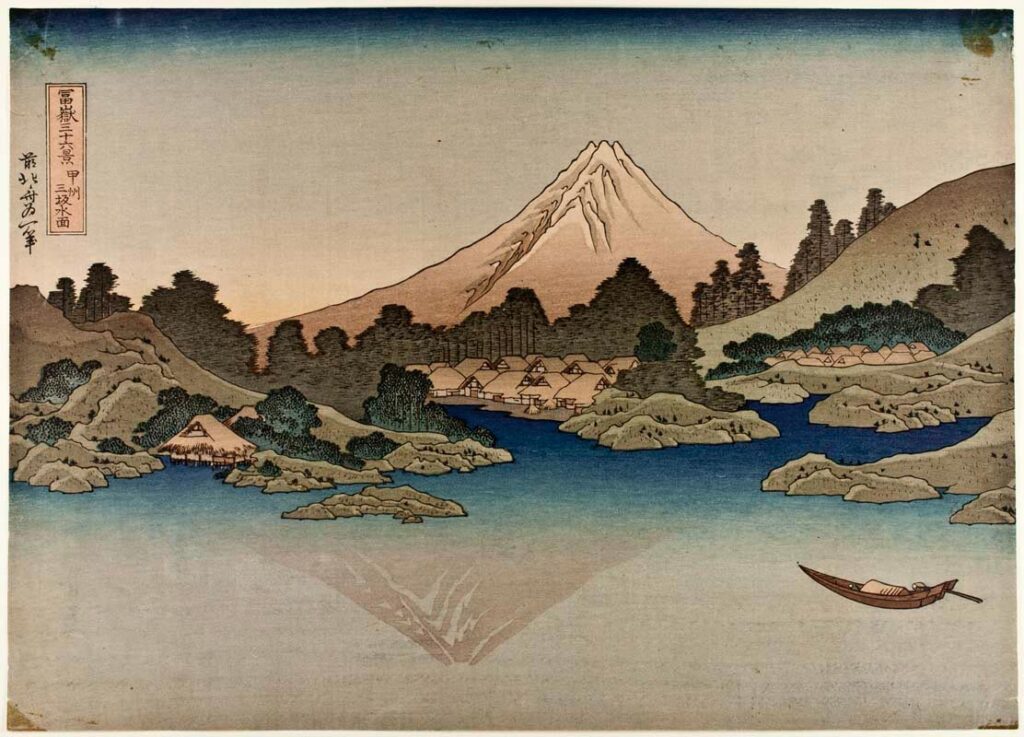
Title: 36 Views of Mt. Fuji [series]–#35
Creator: Katsushika Hokusai
Date: 1829-33
Culture: Japan
Medium: woodblock print; ink and color on paper
Dimensions: 22 x 35 cm
Repository: Wetmore Print Collection, Art History Dept., Cummings Arts Center, Connecticut College, New London
Credit line: Gift of Prof. Caroline Black, Botany Dept., Connecticut College
ID number: black005
Description: This print is #35 in Hokusai’s series of prints depicting Mt. Fuji from different angles and seasons. Mt. Fuji is closely associated with the cultural identity of Japan, often considered a symbol for the nation (Earhart). Here, the mountain stands tall above a small fishing village built on the edge of a lake. In the water, a boat floats peacefully to the right, with the large reflection of the mountain shown in the center. Hokusai manipulates the composition of the image in order to highlight Mt. Fuji’s reflection in the water, placing it at the center of the scene. Hokusai further manipulates the scene by visually distinguishing Mt. Fuji from its reflection below. The mountain stands large and tall above the landscape, whereas the reflected image shows a smaller and weathered mountain peak, possibly capped by snow. In this print, the water’s reflection is not a mirror for reality but an obscured landscape. The visual differentiation between Mt. Fuji and its reflection illustrates the dualities present within the complex culture and identity of Japan.
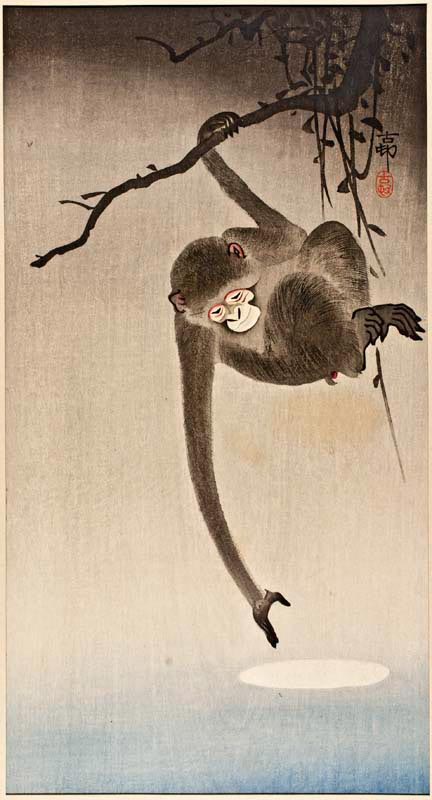
Title: Monkey Reaching for The Moon
Creator: Shosan
Date: 1910
Culture: Japan
Medium: woodblock print; ink and color on paper
Dimensions: 34 x 18 cm
Repository: Wetmore Print Collection, Art History Dept., Cummings Arts Center, Connecticut College, New London
Credit line: Gift of Prof. Caroline Black, Botany Dept., Connecticut College
ID number: black061
Description: This woodblock print is a reference to the famous story told by the Buddha about a group of monkeys enchanted by the moon’s reflection in a pool of water (Aviman). Fooled by the illusion, the monkeys fall into the water, attempting to capture the moon’s reflection. This Buddhist story warns how the spiritually unenlightened cannot distinguish between reality and illusion. The spiritual danger of illusion is illustrated in the Shosan’s print by the monkey’s precarious composition. He is shown hanging from the branch above by just his fingertips, foreshadowing his inevitable fall. The moon’s reflection is an obscured white oval with a distinctly flat appearance. With no real moon depicted in the sky, the viewer can only see its’ reflection floating in the water. Removing the subject of the reflection from the print emphasizes the theme of illusion and abstracted reality and visually fools the viewer the way the monkey in the story was.
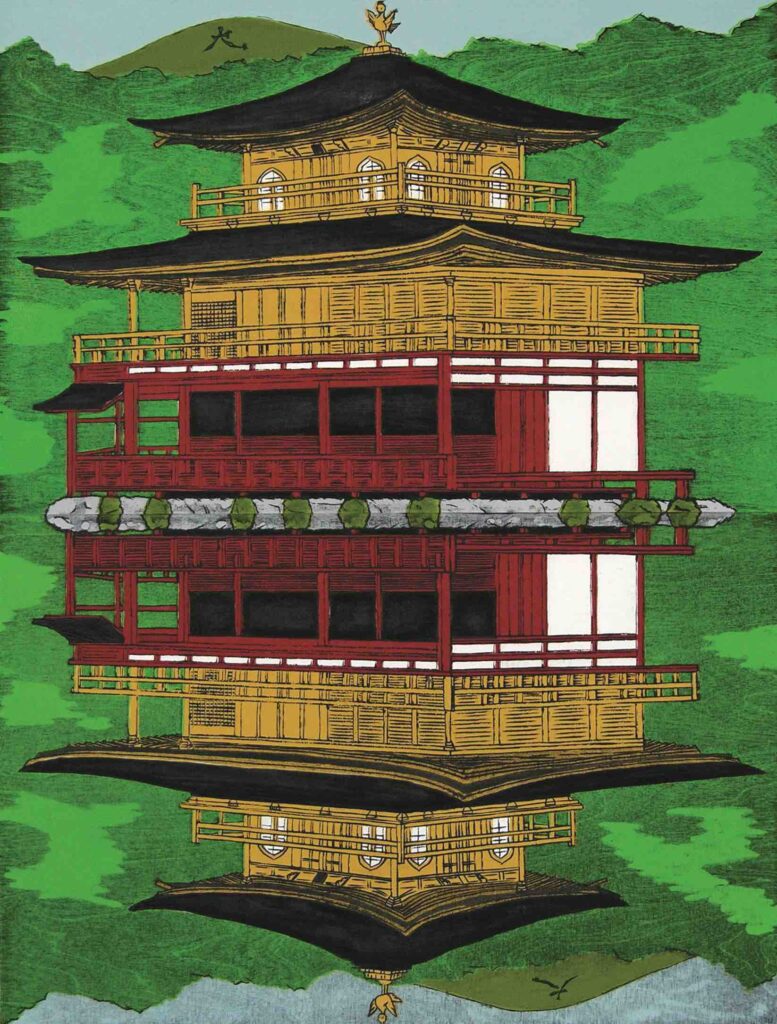
Title: Mirror Pond Kingkakuji
Creator: Nana Shiomi
Date: 2009
Culture: Japan
Medium: woodblock print; ink and color on paper
Dimensions: 96 x 76 cm
Repository: GroundWork Gallery
ID number: Edition of 30
Description: Mirror Pond Kingkakuji by Nana Shiomi depicts the Golden Pavilion, strikingly reflected onto a tranquil pond. The Golden Pavilion is an ancient Buddhist structure built to house the sacred relics of the Buddha. The pavilion’s sublime architecture and lush gardens were designed to create a spiritual paradise on earth. In Shiomi’s print, the placid water is free of disruption, producing a perfectly mirrored image of the temple, making it difficult to discern the real building from its reflection. Shiomi is a contemporary Japanese artist who specializes in traditional Japanese woodblock printing practices. She fuses traditional subjects and methods, like the Golden Pavillion, with a modern perspective. In this piece, reflection illustrates peacefulness, serenity, and even the sense of perfection that is evoked by the spiritual building. This contemporary print uses the ancient Japanese pavilion as a subject to celebrate the timeless beauty of Japanese aesthetics.
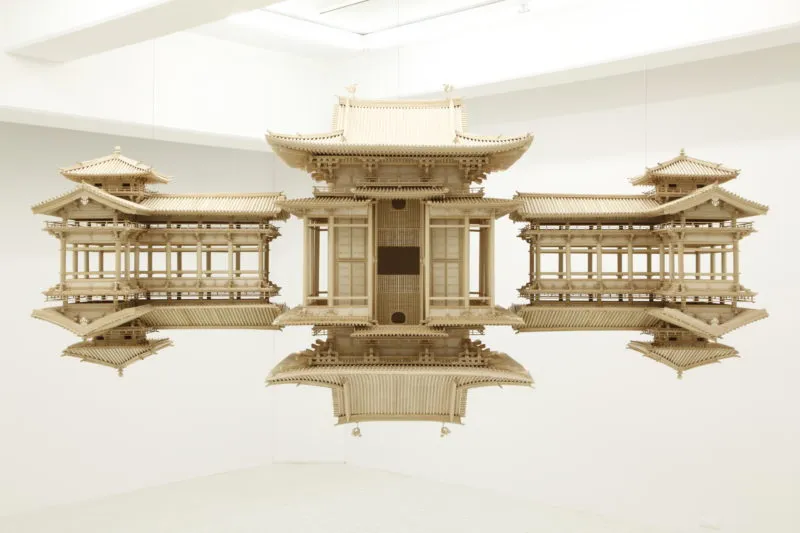
Title: Reflection Model (Perfect Bliss)
Creator: Takahiro Iwasaki
Date: 2010-2012
Culture: Japan
Medium: Japanese cypress, wire
Dimensions: 150 x 280 x 194cm
Repository: Collection: Queensland Art Gallery | Gallery of Modern Art
Credit line: Purchased 2013 with funds from Michael Sidney Myer through the Queensland Art Gallery Foundation
ID number: 2013.001a-e
Description: Reflection Model (Perfect Bliss) by Iwasaki is a miniature wooden model of the Phoenix Hall, a sacred building in the Byodo-in Buddhist temple complex. The Phoenix Hall is a symbol of Japanese national identity, repeatedly appearing in Japanese iconography, like the 10 yen coin (Keehan). The temple was built to represent the Buddhist pure land; it is large and uniquely symmetrical, with reflection pools located directly beneath it (Yiengpruksawan). The building’s reflection in the water creates a dichotomy; one image is real while the other is an illusion. However, Iwasaki’s sculpture fuses reality with illusion, creating a singular solid visual entity. Unlike the traditional Buddhist apprehension regarding illusion, Iwasaki’s sculpture illustrates a modern reinterpretation of reality. Iwasaki materializes the immaterial visuals of reflection and, through this, encapsulates the complexities within Japan’s national identity.
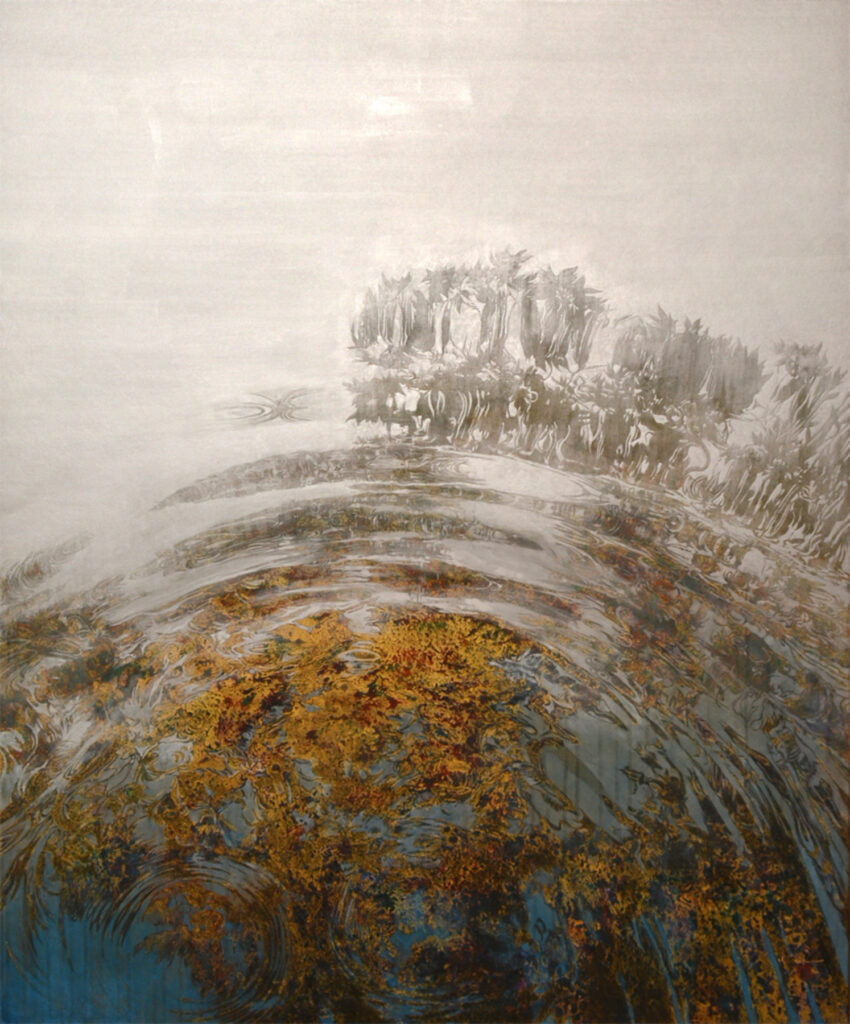
Title: Water
Creator: Yoshihito Kawase
Date: 2019
Culture: Japan
Medium: Nihonga
Dimensions: 46 x 36 in
Repository: Ronin Gallery Japanese & East Asian Contemporary Art
ID number: #JPR-119374
Description: Yoshihito Kawase’s Water is a hyper-realistic painting depicting the branches of a tree reflected onto a pool of water with such clarity it looks like a photograph. While the painting has striking modern realism, Kawase creates this piece using the traditional Japanese Nihonga style. In the painting, the water has been disturbed, distorting the tree’s reflection with a series of expanding ripples. Instead of the reflecting images like a mirror, the water in Kawase’s painting is an unfixed landscape that alters visual perception. Water is part of a series of paintings by Kawase that reflect on the aftermath of the earthquake and tsunami that hit Japan in 2011. The abstracted reflection in the painting conveys the destruction caused by the unexpected natural disaster. The painting also illustrates the duality of water and nature; as a source of life and a source of death. This piece utilizes traditional Japanese painting methods while creating a contemporary aesthetic to reflect on the modern subject of global warming and natural disaster.
Bibliography
Images
Katsushika Hokusai. “36 Views of Mt. Fuji [Series]–#35”. 1829-33. Woodblock print. 22 x 35 (cm). Wetmore Print Collection, Connecticut College. https://oak.conncoll.edu/visual/asian-art/Caroline%20Black%20Collection%20of%20Japanese%20Woodcuts/content/_2312112131_large.html.
Takahiro Iwasaki. “Reflection Model (Perfect Bliss).” 2010. Japanese cypress, wire. 150 x 280 x 194 (cm). Queensland Art Gallery. https://collection.qagoma.qld.gov.au/objects/15931/.
Yoshihito Kawase. “Water”. 2019. Nihonga. 46 x 36 (in). Ronin Gallery. https://www.roningallery.com/water.
Nana Shiomi. “Mirror Pond Kingkakuji”. 2009. Woodblock print. 96 x 76 (cm). GroundWork Gallery. https://www.groundworkgallery.com/product/nana-shiomi-mirror-pond-kingkakuji/.
Shosan. “Monkey Reaching for the Moon.” 1910. Woodblock print. 34 x 18 (cm). Wetmore Print Collection, Connecticut College. https://oak.conncoll.edu/visual/asian-art/Caroline%20Black%20Collection%20of%20Japanese%20Woodcuts/content/_8915774695_large.html.
Texts
“About Kinkaku-Ji .” Shokoku-ji religious corporation. https://www.shokoku-ji.jp/en/kinkakuji/about/.
“Takahiro Iwasaki’s Intricate Miniatures of Ancient Japanese Temples.” 2021.Public Delivery, October 26.
Aviman and Galit. 2014. Zen Paintings in Edo Japan (1600-1868): Playfulness and Freedom in the Artwork of Hakuin Ekaku and Sengai Gibon Taylor and Francis.
Earhart, Bryon. 2015. Mount Fuji: Icon of Japan University of South Carolina Press.
Gauss, Daniel. 2019. “Yoshihito Kawase
at the Ronin Gallery in Manhattan .” The Wall Street Journal, June 12.
Hudson, H. 1971. “Buddhist Teaching about Illusion.” Religious Studies 7 (2): 141-151. http://www.jstor.org/stable/20004879.
Keehan, Reuben. 2013. “Highlight: Takahiro Iwasaki’ Reflection Model (Perfect Bliss)’.” Queensland Art Gallery, August 27. https://blog.qagoma.qld.gov.au/recent-acquisition-takahiro-iwasaki-reflection-model-perfect-bliss/.
Koriyama, Naoshi. 1967. “The Kinkaku-Ji Temple.” The Christian Science Monitor (1908-), 8. https://login.peach.conncoll.edu/login?url=https://www.proquest.com/historical-newspapers/kinkaku-ji-temple/docview/511003058/se-2?accountid=10255.
Yiengpruksawan, Mimi Hall. 1995. “The Phoenix Hall at Uji and the Symmetries of Replication.” The Art Bulletin 77 (4): 647-672. doi:10.2307/3046141. http://www.jstor.org/stable/3046141.